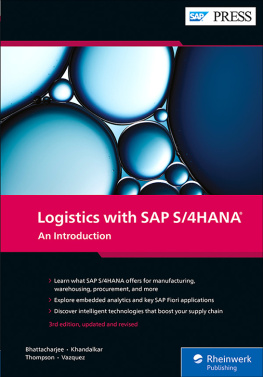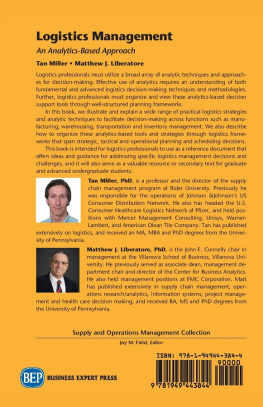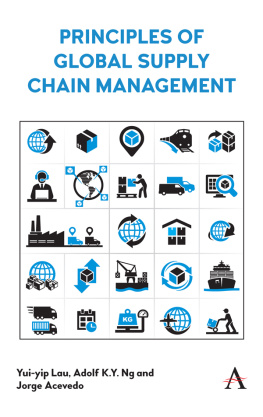
Series Editor
Jean-Paul Bourrires
Hospital Logistics and e-Management
Digital Transition and Revolution
Edited by
Philippe Blua
Farouk Yalaoui
Lionel Amodeo
Michal De Block
David Laplanche

First published 2019 in Great Britain and the United States by ISTE Ltd and John Wiley & Sons, Inc.
Apart from any fair dealing for the purposes of research or private study, or criticism or review, as permitted under the Copyright, Designs and Patents Act 1988, this publication may only be reproduced, stored or transmitted, in any form or by any means, with the prior permission in writing of the publishers, or in the case of reprographic reproduction in accordance with the terms and licenses issued by the CLA. Enquiries concerning reproduction outside these terms should be sent to the publishers at the undermentioned address:
ISTE Ltd
27-37 St Georges Road
London SW19 4EU
UK
www.iste.co.uk
John Wiley & Sons, Inc.
111 River Street
Hoboken, NJ 07030
USA
www.wiley.com
ISTE Ltd 2019
The rights of Philippe Blua, Farouk Yalaoui, Lionel Amodeo, Michal De Block and David Laplanche to be identified as the authors of this work have been asserted by them in accordance with the Copyright, Designs and Patents Act 1988.
Library of Congress Control Number: 2019944252
British Library Cataloguing-in-Publication Data
A CIP record for this book is available from the British Library
ISBN 978-1-78630-500-8
Preface
At a time when new information and communication technology (NICT) is disrupting daily life and seems, day by day, to be exerting greater influence on our private lives, it is informative to study the real impact it may have in the hospital world. We must examine the use to which this may be put in the future. Although health establishments are not best equipped to optimize the use of NICT, there is a favorable shift taking place in mindsets and the use of these technologies.
Approaching these challenges and achieving set objectives are both difficult tasks and cannot be carried out without collaboration between the world of health and the digital world (both industrial and academic). In this book, readers will discover a fruitful collaboration that has existed for several years now between a city hospital, where the number of patients continues to grow, and a research team that is specialized in analyzing data on health and using algorithms for decision making through artificial intelligence.
What impact do these new technologies have on hospitals? Which are the technical solutions that are best suited to the hospital setting? Are health professionals prepared for this digital transformation? Will the quality of healthcare deteriorate?
These are but a few of the questions that leap to the fore today and have received few or no answers yet. While it may be obvious that no sector can escape this transformation, the introduction of technological innovations in the field of health must be studied. This will take place through preventive measures, measures supporting the patient at home and for improving follow-up, both within and outside the hospital.
The objective of this book is to examine how information technology is currently being used in health establishments, to state what should be done and to propose possible uses of NICT, artificial intelligence (AI) and operational research (oR).
This book will give readers the chance to enrich and broaden their knowledge of information systems in hospitals. It illustrates the importance of new technology and how it can transform health. Furthermore, even though every one of us is familiar, in some way, with hospitals (through routine visits or even emergency procedures), the first few chapters offer readers a greater understanding of information systems in hospitals, the data that the hospital uses to function and why optimizing data management and resources may change the quality of healthcare that each patient receives.
The book, thus, provides an overview of the hospital world and lists out the requirements of its health information system. It also studies medical information, its history, supports and challenges. In addition to the challenges and obstacles to the flow of information, we also have logistical flows, which are intimately related to the information flows. Hospital logistics have been broadly explained using the case study of the Champagne Sud hospitals (CSH).
The book presents two studies that emerged from the collaborations between the CSH and university research on how high-performing decision-making tools may draw profiles from these NICT, AI and OR, and use these to improve the quality of service provided to patients and to improve the logistical organization of the hospital.
The first study examines forecasting patient flow into emergency care, and how this could make it possible to improve the management of their admission and the organization of services.
The second study looks at the optimization of the distribution and collection of product flows (food, linen, medicine and materials).
This scientific collaboration is undoubtedly ushering in the hospital of the future, and presages important and essential advances.
The final chapters discuss in detail the studies and flagship solutions that have been proposed in this collaboration. After many years, and after a nervous beginning, marked by the declaration that, "it is never possible to predict how many patients will come into emergency care", we have been able to help the hospital in Troyes predict patient inflow with an accuracy rate of almost 95%.
This project may be summarized by a simple motto: using data, it is always possible to predict or foresee the future in a way that benefits everyone.
Farouk YALAOUI
July 2019
Hospitals and Management
1.1. Introduction
At a time when new information and communication technologies (NICTs) are disrupting our daily life and, every day, exerting greater influence on our private life, it is instructive to study what impact they will have in the hospital field. It is important to ask ourselves how these technologies can be used in the future. Let us state this right away: health establishments are not best prepared to optimally use NICT. Information technology (IT) has been disliked in this field for quite some time.
The hospital world is one of those rare spheres where, even today, secretaries frequently use typewriters for letters. The blame for this can be apportioned among several parties: any number of health ministers have extended an outdated system, preferring written documents and physical consultations over paper-free exchanges; any number of hospital directors have regarded digitization as an expense rather than an investment; any number of doctors have resisted attempts to digitize medical files.
The aim of this chapter is not to point fingers, but to establish the current state of IT in health establishments, specify what needs to be done and to look at the possible uses that can be made of NICT.
1.2. Imperfections in hospital information technology
Hospital IT systems often suffer from the same shortcomings from seven deadly sins! These are as follows: the engineers dream, the lack of support, the jargon, hospital-centrism, ergonomic heresy, forgetting productivity and the absence of an IT strategy.
Next page











